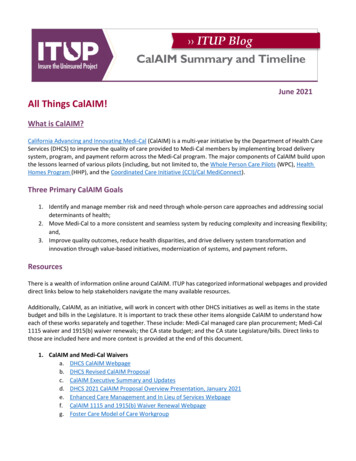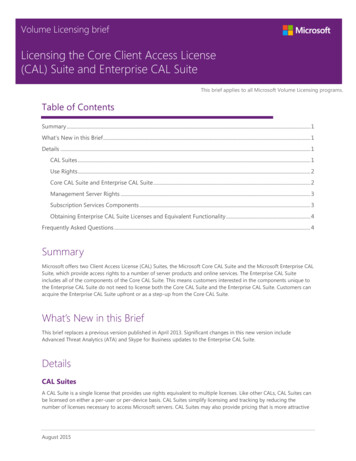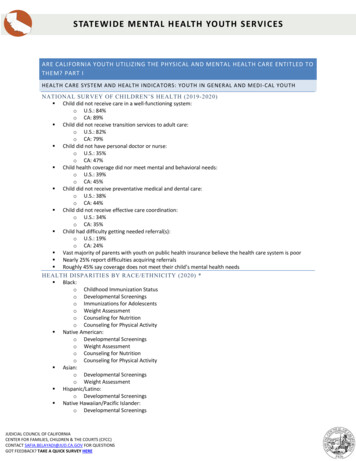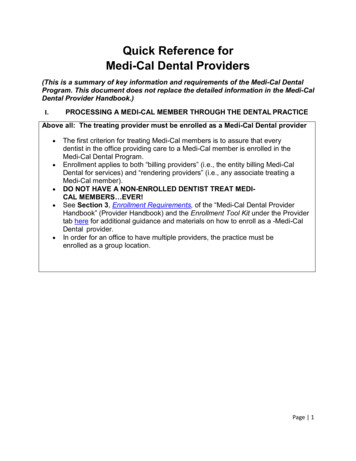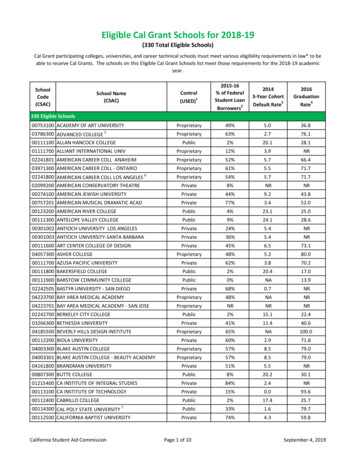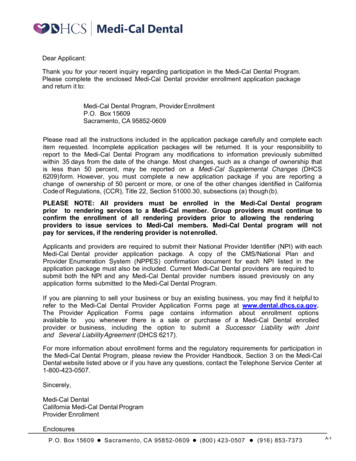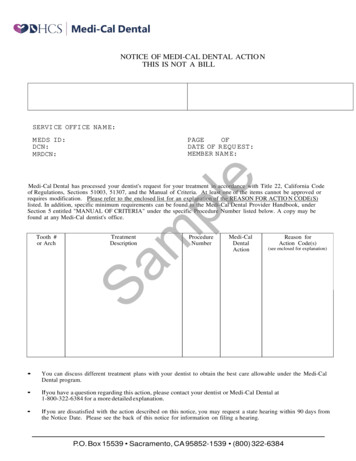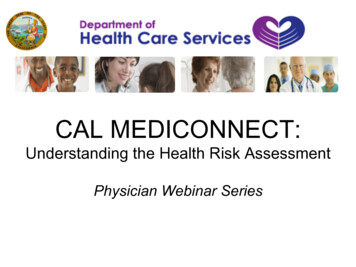
Transcription
CAL MEDICONNECT:Understanding the Health Risk AssessmentPhysician Webinar Series
Today’s Webinar This webinar is part of a series designed specifically for CAPGmembers. For a general overview of the initiative, visit CalDuals.org andreview the “What Doctors Need to Know” PowerPoint. Today’s subject matter will be in-depth on the topic of theHealth Risk Assessment in the Cal MediConnect program.2
Today’s Webinar Brief overview of Cal MediConnect What: HRA Basics– Risk Stratification– Assessment Why: HRAs Will Support Physicians How: Conducting the Assessment– Timelines– ReportingDRAFT3
Medicare & Medi-Cal TodayMedi-Cal ServicesMedicare Services Hospital carePhysician & ancillaryservicesShort-term skilled nursingfacility careHospiceHome health carePrescription drugsDurable medical equipment Medicare cost sharing (Medicarewrap)Long-term nursing home (afterMedicare benefits are exhausted)Long-term home and communitybased services (including CBAS,MSSP, IHSS, Nursing Facilities,HCBS waivers)Prescriptions, durable medicalequipment, and supplies notcovered by MedicareDRAFT4
Why Cal MediConnect? Some people with multiple chronic conditions see manydifferent doctors and have multiple prescriptions. This is common among people with both Medicare andMedicaid, referred to as “dual eligibles” or Medi-Medis here inCalifornia, who often are sicker and poorer than otherbeneficiaries. Today’s care delivery system doesn’t always support the carecoordination many people need. This leads to increased riskof admission to the hospital or nursing home. Coordinated care is a critical component of the CalMediConnect program, which combines Medicare and MediCal services in one health plan.DRAFT5
What is an HRA? The HRA will evaluate an enrollee’s current health statusand establish a platform to begin building caremanagement and develop the enrollee’s individual careplan (ICP). As a part of plan readiness for Cal MediConnect, everyparticipating plan developed assessment tools, whichhave been approved by CMS and DHCS. The HRA has two components. Risk stratification Health Risk AssessmentDRAFT6
Required Assessment Components Risk Stratification Prior to beneficiary enrollment, DHCS will provide the plans withMedicare and Medi-Cal data to help them stratify enrollees ashigh- or low-risk. Plans will use an electronic tool to search the data to identifynewly enrolled individuals who are considered higher or lowerrisk. High risk: enrollees who are at an increased risk of having an adversehealth outcome or worsening of their health status if the health plandoes not contact them within 45 calendar days of their coverage date. Low risk: all other enrollees, and those in nursing homes. The healthplan will contact them within 90 calendar days of their coverage date. Health Risk Assessment This component will assess an enrollee’s current health risk forthe purpose of developing individualized care plans. This will involve outreach and communication with the enrollee.DRAFT7
Data Used in HRAs DHCS and CMS will provide the following historicalclaims-related data to the plans no sooner than 60 daysprior to beneficiary enrollment. Plans will also receivedata through a monthly upload:ü Medi-Cal Dataü Medi-Cal Treatment Authorization Request dataü Medicare Part A and B dataü Medicare Part D dataü IHSS data (this data is available to assist in carecoordination)§ Payment data§ Assessment dataDRAFT8
Assessment Requirements Each plan has developed their own assessment, but allplan assessments must include some standard topics. The assessment identifies an enrollee’s primary, acute,LTSS, and behavioral health and functional needsincluding: Behavioral health needs Substance use needs Assistance in key activities ofdaily living Chronic conditions Dementia Disabilities Cognitive and mental status Functional impairments The capacity to make informeddecisionsDRAFT9
Sample HRA QuestionsDRAFT10
Sample HRA QuestionsDRAFT11
Sample HRA QuestionsDRAFT12
Sample HRA QuestionsDRAFT13
Why the HRA Supports Physicians The health plan care manager will make results from an enrollee’sassessment available to providers 10 days after completion. The data will automatically go to all providers on an enrollee’sinterdisciplinary care team. The HRA will help establish which providersshould be on this team. This will vary by health plan. Some plans (or their vendors) may share datafiles electronically, others may fax information to a physician or physiciangroup office. Check with your plan on how the data will arrive. If a physician believes an enrollee was incorrectly classified as highor low risk, the physician may contact the health plan to ask for areassessment if they believe it will benefit the enrollee’s care andbetter inform the other providers involved in the care of the enrollee.DRAFT14
Conducting the Assessment Plans will attempt to conduct the assessment in-person as thepreferred and first option. Plans also will conduct theassessment by telephone or by mail, depending on theindividual’s needs and preference. The health plans will contact enrollees about their assessmentwith at least five phone calls followed by a letter or in-personvisits. Plans will provide assessment materials in the enrollee’spreferred language or alternative formats upon request. Plans will share results of the assessment within 10 days ofcompletion with an enrollee’s provider.DRAFT15
Assessment Timeline: High RiskHigher risk: For individuals identified by the risk stratificationas higher risk, plans must complete the assessment within 45calendar days after their coverage date. Beneficiaries withIHSS hours equal to or greater than 195 hours per month areconsidered higher risk.Time FrameActivityDay 1Enrollee begins coverageDay 1 to Day 30Health plan attempts at least five phone calls (two within tenbusiness days of the enrollee’s coverage date) and first offers theenrollee the option of an in-person HRA, or if the enrollee prefers,the health plan may complete the HRA by telephone at that time.Day 31 to Day 40If the health plan is unable to complete the assessment by day30, the health plan must mail the assessment to the enrollee.Day 41 to 45If the enrollee has not completed the assessment, the health planmust call again.6 months after enrollmentIf the health plan is unable to complete the assessment due tolack of response from the enrollee, it must mail the assessmentsurvey to the enrollee.DRAFT16
Assessment Timeline: Lower Risk Nursing facilities or lower risk: For individuals innursing facilities or those identified as lower risk, plansmust complete the assessment within 90 calendar daysafter their coverage date.Time FrameActivityDay 1Enrollee begins coverageDay 1 to Day 30Health plan attempts at least two phone calls within 30 days ofthe enrollee’s coverage date to first offer the enrollee the option ofan in-person HRA or, if the enrollee agrees, the health plan maycomplete the HRA by telephone at that time.Day 31 to Day 60If the health plan is unable to complete the assessment by day30, the health plan must mail the assessment to the enrollee.Day 61 to 85If the assessment is still not completed by day 60, the health planmust send a second mailing to the enrollee.Day 86 to Day 90If the enrollee has not completed the assessment, the health planmust attempt another phone call.6 months after enrollmentIf the health plan is unable to complete the assessment due tolack of response from the enrollee, it must mail and assessmentsurvey to the enrollee.DRAFT17
Conducting the Assessment Plans have identified the personnel or vendors who willconduct the HRA. The requirements for personneladministering the HRA are as follows: Personnel trained in the use of the assessment instrument. Personnel will be trained for cultural and linguistic competency,needs of individuals with functional impairment, and long-termservices and supports (LTSS) needs. Professionally knowledgeable, licensed and/or certifiedpersonnel will review, analyze, identify and stratify health careneeds for higher risk enrollees.DRAFT18
Reassessment Strategy Plans will conduct reassessments at least annually, withintwelve months of the last assessment, or as often as thehealth and/or functional status of the individual requires. The health plan will regularly use electronic health recordsand claims data to inform reassessments and to identifyindividuals as high risk, with newly diagnosed acute andchronic conditions, or high frequency emergency departmentor hospital use, or LTSS or Behavioral Health referral. Physicians or enrollees can always request a reassessmentfor an enrollee.DRAFT19
Reporting Requirements Each plan must report to DHCS and CMS on the number of: Members who were successfully contacted and by whatmethod. Members determined as higher risk or lower risk. Members who completed the risk assessment survey andwho declined the survey. Members who, after completing the assessment, weredetermined to be in a different risk category than initiallyassigned. CMS and DHCS are developing a reporting template for thehealth plans.DRAFT20
Wrap Up: HRAs HRAs will evaluate an enrollee’s healthstatus and inform their individual careplan. HRAs are a new source of information tohelp physicians provide coordinated care. Ask Cal MediConnect plans in your areaabout when and how you’ll start receivingmore information.DRAFT21
Continuity of CareREMINDER - Continuity of Care:if a physician is not in the plan network Medicare Services Medi-Cal Services Up to six months Up to 12 months This applies to doctorsincluding specialistslike cardiologists,ophthalmologists, andpulmonologists Note: does not applyto providers ofancillary services likedurable medicalequipment (DME)DRAFT22
Other Upcoming Webinars Wednesday, February 5th, 12 – 1 pm:Understanding the Interdisciplinary CareTeam (ICT) and Care Plans Wednesday, February 12th, 12 – 1 pm:Working with In-Home SupportiveServices (IHSS) Wednesday, February 19th, 12 – 1 pm:Introduction to Care Plan Option (CPO)ServicesDRAFT23
References & Questions Care Coordination Standards: visithttp://www.calduals.org/2013/02/20/cc standards/ Provider Relations at the Health plans:visit www.calduals.org and select yourcounty from the navigation Email info@calduals.orgDRAFT24
Day 31 to Day 40 If the health plan is unable to complete the assessment by day 30, the health plan must mail the assessment to the enrollee. Day 41 to 45 If the enrollee has not completed the assessment, the health plan must call again. 6 months after enrollment If the health plan is unable to complete the assessment due to
